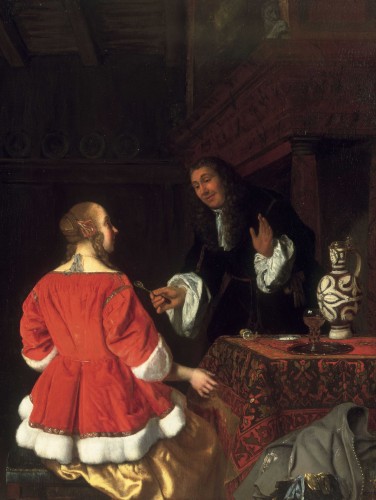From the museum press release, 5 August 2014
The Bayerische Staatsgemäldesammlungen have turned down a request from the descendents of banker Carl Hagen (1856-1938) for the return of the painting ‘Das Zitronenscheibchen’ (The Lemon Slice) by Jacob Ochtervelt on the grounds that the available evidence does not support their claim that the painting was unlawfully acquired as a result of Nazi persecution.
Reasons for the decision
Following extensive research, the Bayerische Staatsgemäldesammlungen are certain beyond all reasonable doubt that the senior civil servant Carl Thürling (Amsterdam and Berlin) was the beneficial owner of the painting ‘Das Zitronenscheibchen’ by Jacob Ochtervelt until it was auctioned in 1938. The banking house Hagen & Co., in which Carl Hagen played an instrumental role, only held a security interest in the painting. Carl Thürling had granted the security over this and twenty other paintings in order to secure a loan in six figures that he borrowed in the 1920s. Among the other paintings from Carl Thürling’s collection was the artwork River landscape by Jan van Goyen (Mount Holyoke Museum, Massachusetts, USA).
At the behest of the bank Hagen & Co., the security was enforced and ‘Das Zitronenscheibchen’ sold to Johannes Hinrichsen and Hans Bammann in 1938 for 35,000 reichmarks, which experts have confirmed was a fair price on the market at that time. Shortly thereafter it came to the collection of Fritz Thyssen (1873-1951) from whom the Bayerische Staatsgemäldesammlungen acquired the painting in 1992.
The Bayerische Staatsgemäldesammlungen takes all claims very seriously concerning the restitution of artworks that were looted during the Nazi era and never returned. It investigates each new piece of information in order to find fair and just solutions for those who were persecuted and their descendents. An artwork may be restituted if it was expropriated from its rightful owner under duress or threat of persecution. This does not apply in the case of ‘Das Zitronenscheibchen’ by Jacob Ochtervelt. Carl Thürling was the beneficial owner of the painting until 1938, and did not lose his title to the painting because of persecution but because he had defaulted on his loan. Furthermore, Carl Thürling did not belong to any of the groups that were persecuted by the Nazis, and was in fact a member of the Nazi Party (NSDAP).
The banking house Hagen & Co. thus only held a security interest in the paintings which terminated when it was enforced during the liquidation of Hagen & Co. in 1938. In accordance with the Washington Principles, the joint declaration of the Federal German government, the German states and the national associations of local German authorities on the tracing and return of Nazi-confiscated art, especially of Jewish property from 9 December 1999, as well as all pertinent restitution laws, the enforcement of a security interest does not justify the claim for the restitution of these 21 paintings.
The background The descendents of the banker Carl Hagen, who died in 1938, approached the Bayerische Staatsgemäldesammlungen in 2012 with a request for the return of the painting ‘Das Zitronenscheibchen’ by Jacob Ochtervelt. The research required for this case turned out to be extremely complex. Significant documents were only received by the Bayerische Staatsgemäldesammlungen in May and June of this year. Due to data protection laws, the Bayerische Staatsgemäldesammlungen had to rely on the cooperation of the descendents of the Hagen family and the previous shareholders of the Hagen & Co. bank to gain access to these documents. In addition, prior to 2009 there had been no reason to suspect that the painting ‘Das Zitronenscheibchen’ by Jacob Ochtervelt had ever been unlawfully seized from a previous owner. The provenance of the painting in the 20th century was generally accepted until the claim for restitution was filed by Carl Hagen’s descendents, and does not mention an owner of Jewish origins at any time, including the relevant time period of the Nazi regime.
The research revealed that the owner of the painting, Carl Thürling, had used the painting as security for a loan that he had applied for. A security agreement grants the creditor a right in property owned by a debtor to assure, for example, the repayment of a loan. In the case that the obligations of the agreement are not met by the debtor, the creditor then has the right to enforce the security interest (e.g. by selling or auctioning the secured property). A security interest does not, however, automatically grant the creditor the right to permanently and definitively retain possession of the property. The Bayerische Staatsgemäldesammlungen first examined the claim internally.
As the subject matter of the case was unusual for a restitution claim, involving, for instance, issues of banking law, the Bayerische Staatsgemäldesammlungen decided to commission an external audit to verify the results of its own research. The audit was carried out by legal experts who assessed the alleged right of Carl Hagen’s descendents to restitution, taking pertinent aspects of economic history into account. Their report confirmed the results of the research undertaken by the Bayerische Staatsgemäldesammlungen.

